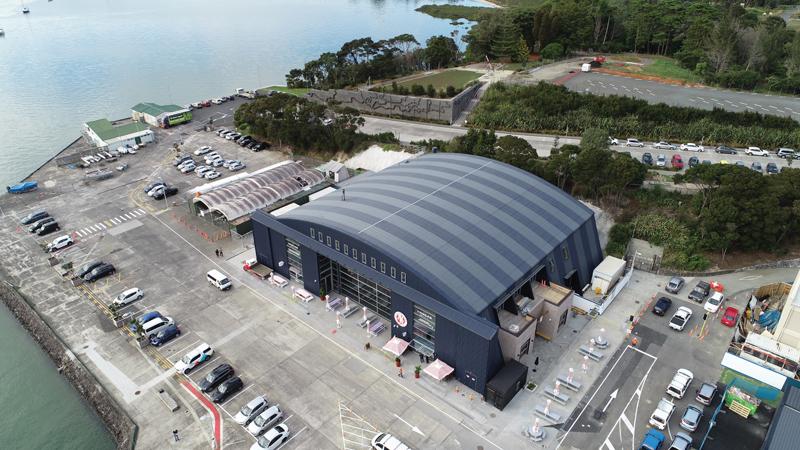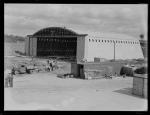The Sunderland Hangar re-born at Hobsonville

When a Project Unite crew first walked onto the Catalina Bay hangar site at Hobsonville last year what greeted them was a structural skeleton, only the bones remaining of the historical RNZAF facility which had been home to the air force’s Sunderland seaplanes.
The building, which had lain idle for years, was about to be transformed by construction company L T McGuinness Auckland Ltd into a mixed-use precinct featuring retail, hospitality and commercial spaces including a micro- brewery; Project Unite was engaged to install the external cladding.
Owned by Auckland Council, the Hobsonville Land Company (HLC) was established by the government to oversee development of defence department land at Hobsonville with a view to increasing the supply of housing in Auckland. Willis Bond & Co Ltd is the developing company of the hangar and six other buildings refurbished at Catalina Bay, having won the rights to develop in 2016.
Built in 1939, the Sunderland hangar had been designed with a lightweight steel roof truss system, 27m high with the hangar interior free of supporting posts so as not to interfere with the large planes that were accommodated in the space.
The shell of the Category 2 listed building was all that remained when foundation RANZ member, Project Unite, commenced the work in July last year to provide roofing and wall cladding to the inspired restoration plan of Simon McLean at Cheshire Architects Ltd.
Respecting the significant wartime and military history of the RNZAF base, the Sunderland hangar has been sensitively stripped back to allow the removal of asbestos ahead of the building’s new livery to transform the building.
Inspired choice
Key to the exterior cladding of the project was the selection of Roofing Industries True Oak® Corrugate (Material Colorcote Magnaflow .55BMT) ideally suited for historic buildings with its rounder and deeper profile and fulfilling the architect’s need to provide aesthetic and historic appeal. The predominant colour for the cladding is New Denim Blue, interlaced with “stripes” of Slate Blue – an ingenious feature given the links to the military greys in a striped pattern once used as camouflage by seaplanes to detect radar from above - back in the day. After the extensive work afforded to the architects on the suitability of True Oak Corrugate for this contract, the end result must be pleasing to Roofing Industries’ David Eccles-Hall and also Steve Haines from PCC for his involvement in this development including provision of the aerial images included with this feature.
The 1500m2 space on the lower floor is home to a new restaurant, bar and Little Creatures microbrewery while a 1300m2 mezzanine level has been created to accommodate offices with a 13m ceiling height. Across the front of the Sunderland facility is a 12m high atrium of glass offering a view of the brewery vats and there are bi-fold doors opening to the public plaza.
There was a small amount of Roofing Industries’ Trimclad to the interior of the building, this time in a colour finish of Sandstone Grey and flashing work associated with the cladding was installed, in the appropriate colour, with metal guttering and downpipes manufactured from a mixture of purpose-made stainless steel and roll formed Magnaflow.
Draping
A unique feature of the roofing is the draping of the True Oak profile. The lengths were originally going to be 35m draped curved but it proved too difficult to get to site with limited access available. The roof sheeting ran from East to West, incorporating laps along the run of the sheet, starting with a bull-nosed sheet to both gutter lines followed by a 9.3 metre sheet (again to both sides of the roof apex), up towards the apex and then finally a 19.9 metre sheet naturally draping over the apex and lapping into each of the 9.3 metre sheets. Other 1.7 metre sheets were then spring curved and end lapped to come down the side of the building.
Accuracy of the lay was extremely important to ensure the striping effect was achieved. The bull-nosed sheeting to both sides of the building was installed in such a way that it stood 100mm proud of the vertical cladding below but for reasons of both colour coordination and best water flow, the corrugations all line up. Exacting work for the Project Unite installing team. Water is discharged at the base of the cladding into concrete gutters and the whole effect of the draped roofing and striped exterior is remarkable. It’s admitted that there was a degree of difficulty around some of the flashing detail but nothing “that became hard”.
Formation and over flashing for an air conditioning unit and a flute for a pizza oven were completed by Project Unite along with forming and over flashing for a number of windows to the vertical cladding which provide light emission – they don’t open.
For the majority of the contract Project’s crew size was four, split into two-by-two to handle the bull nose and the shorter roof sheets. That crew was supplemented with another member when the central roof sheets were installed and then up to seven crew when the vertical cladding was installed. All of this was under the watchful eye of on-site foreman Jonny Smythe and his ability and attention to detail is excellent. There was also Project’s Site Supervisor Richie Powell giving the contract his essential ‘overview’ of progress on the contract.
Safety
Contractor L T McGuinness had installed safety railings which Project Unite supplemented with their own safe edge protection where it was considered necessary to ensure the safety of the roofing crew. Project also included their 26m and 18m booms on site together with a 14m platform to assist with access and safety.
Project Unite cannot speak highly enough of their involvement with the contractor L T McGuinness and that’s based on their portfolio of major buildings for the country’s leading contractors. Says Mike Sentch, managing director of Project Unite: “They were excellent to deal with as was the superb service we received from Roofing Industries which is clear evidence that when a collaborative approach is taken by all those involved in a contract, a favourable outcome results”.






